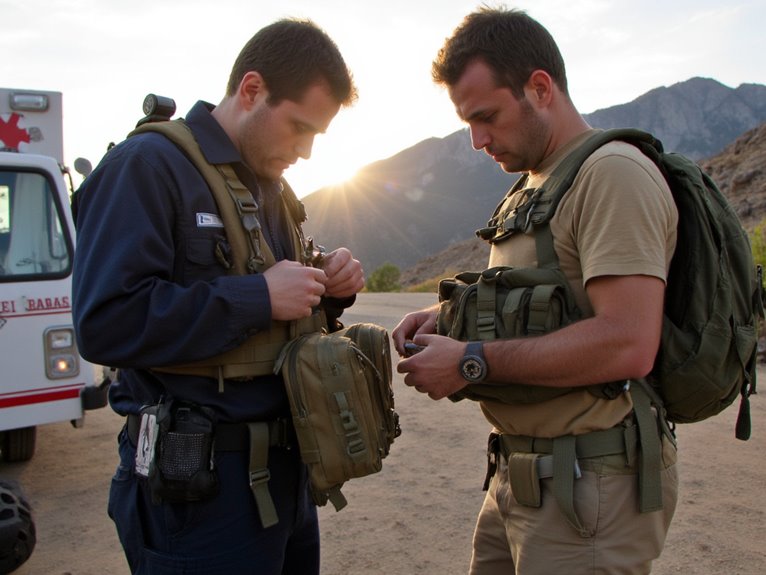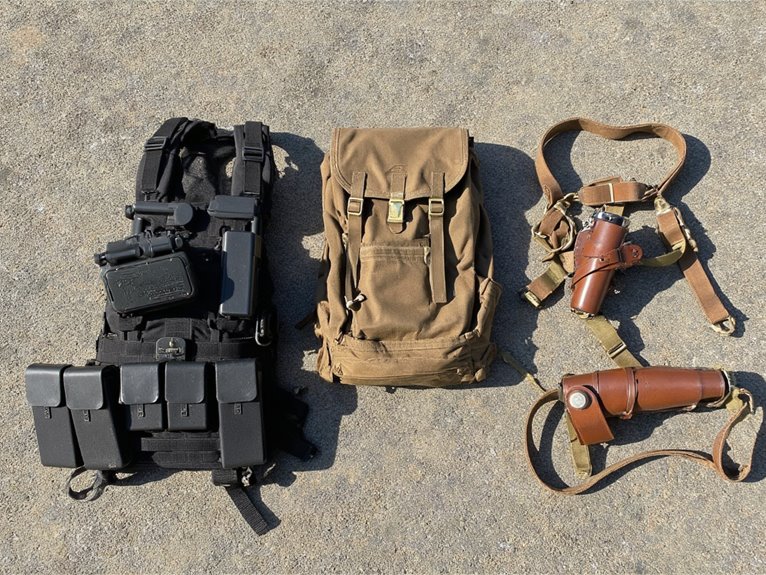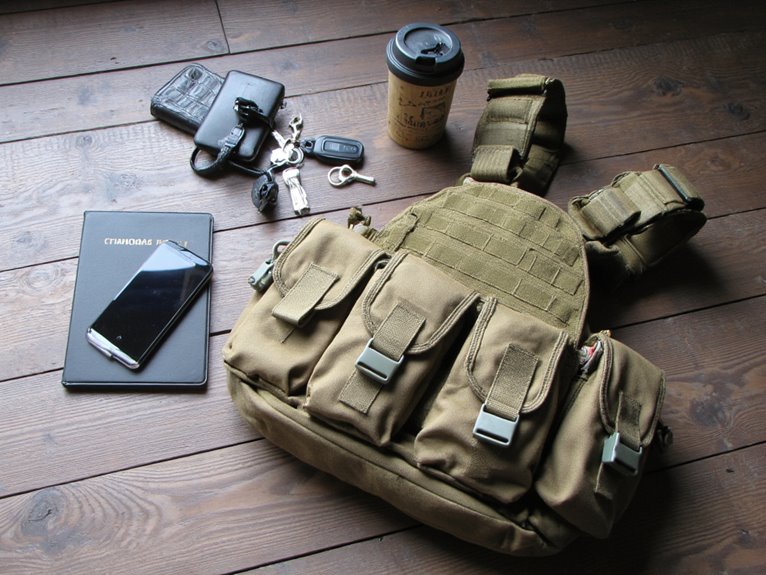Tactical Chest Rigs in Civilian Life: Useful or Overkill?
You’ll find tactical chest rigs genuinely useful for emergency response, outdoor activities, and situations requiring quick gear access, but they’re overkill for routine daily carry. These MOLLE-compatible systems excel at distributing weight across your torso while providing immediate access to medical supplies, communications, or survival gear. However, they’re unnecessary for most urban environments and can draw unwanted attention. The projected 15-20% annual growth in civilian demand reflects rising safety concerns, though proper assessment of your specific needs versus preparedness mindset determines ideal selection.
We are supported by our audience. When you purchase through links on our site, we may earn an affiliate commission, at no extra cost for you. Learn more. Last update on 26th December 2025 / Images from Amazon Product Advertising API.
Notable Insights
- Tactical chest rigs provide rapid gear access and weight distribution benefits for outdoor enthusiasts and emergency preparedness scenarios.
- Market growth reflects rising civilian interest driven by safety concerns, urban crime rates, and increased emergency preparedness mindset.
- MOLLE webbing systems offer extensive customization for carrying medical supplies, communication devices, and specialized equipment based on specific needs.
- Visible tactical equipment may draw unwanted attention and create social complications in routine urban or casual settings.
- chest rigs excel in confined spaces and dynamic activities but backpacks offer superior bulk storage for most civilian applications.
What Are Tactical Chest Rigs and How Do They Work?
Tactical chest rigs are lightweight, harness-like systems that position essential gear directly on your chest for immediate access.
These systems place weight close to your body’s center of gravity, improving balance and reducing fatigue during extended use.
You’ll find them constructed from durable nylon or Cordura materials with MOLLE webbing for customization.
The adjustable shoulder straps and H-harness design distribute weight across your shoulders and back effectively.
Most rigs feature dedicated mag pouches for rifle or pistol magazines, plus compartments for communication devices and medical supplies.
Their tactical versatility extends beyond military applications into civilian activities like hiking and hunting.
The strategic gear organization allows you to retrieve equipment without removing the rig, maintaining mobility while keeping critical items within immediate reach. Unlike plate carriers that prioritize ballistic protection, chest rigs focus solely on gear carrying capabilities. The front placement design ensures quick access to gear during high-pressure situations where speed is crucial.
Functional Benefits for Emergency Responders and Outdoor Enthusiasts

Beyond their basic construction and design principles, chest rigs deliver measurable performance advantages that directly impact operational effectiveness in demanding environments.
You’ll experience rapid access to critical supplies through strategically positioned compartments that keep gear secure yet immediately reachable. This field functionality translates into reduced response times during emergency interventions.
Weight distribution across your torso minimizes fatigue during extended operations, while MOLLE webbing enables precise customization for specific mission requirements.
The recreational versatility extends beyond emergency services.
You can configure these systems for hiking, hunting, or adventure activities where mobility matters.
Modular attachment points accommodate first aid kits, communication devices, and navigation tools. Quick reconfiguration supports different scenarios without carrying multiple bags, maintaining situational awareness while ensuring essential equipment remains accessible during high-stress situations. The ergonomic design proves particularly beneficial for outdoor enthusiasts during extended field activities where comfort directly impacts performance. Waterproof construction protects essential gear from rain or accidental spills during demanding outdoor conditions. Dropping your pack at cache points provides mission adaptability while maintaining access to essential gear in your chest rig.
Market Growth and Consumer Motivations Behind Civilian Adoption
You’re witnessing a tactical gear market that’s grown from $1.3 billion in 2023 to a projected $2.1 billion by 2033, with chest rigs capturing an increasing share of civilian purchases.
Your decision to buy tactical gear now aligns with three primary market drivers: heightened personal safety concerns following recent global events, explosive growth in outdoor recreation activities requiring specialized load-bearing equipment, and the rising appeal of tactical aesthetics in everyday carry culture.
You’ll find that manufacturers are responding to this civilian demand by developing chest rigs with modular attachment systems, weight distributions optimized for 8-12 hour wear periods, and color schemes that shift seamlessly from outdoor environments to urban settings.
This tactical gear trend parallels the security equipment market’s shift toward civilian applications, similar to how floor safes have evolved from exclusively commercial use to residential security solutions for home protection.
Growing Safety Concerns Drive Sales
As safety concerns escalate across urban and rural communities, civilian demand for tactical chest rigs has surged beyond traditional outdoor recreation markets.
Your safety perception directly influences purchase motivation as crime rates and emergency scenarios shape buying decisions. Media coverage amplifies threat awareness, driving proactive equipment acquisition. Social platforms spread preparedness messaging, normalizing tactical gear ownership among non-military users.
Defense industry trends filter into civilian markets, making specialized equipment mainstream.
Key market drivers include:
- Rising urban crime rates creating demand for personal protective equipment
- Emergency preparedness mindset following natural disasters and civil unrest
- Improved accessibility through online retail and targeted marketing campaigns
- Enhanced comfort designs making tactical gear suitable for everyday civilian use
You’ll find manufacturers adapting military-grade specifications for civilian applications, emphasizing versatility and daily wearability.
Outdoor Recreation Market Expansion
While security concerns fuel one segment of tactical gear adoption, outdoor recreation represents the largest civilian growth market for chest rigs.
You’ll find this expansion driven by fundamental shifts in outdoor trends toward multi-day hiking, survival training, and tactical sports participation.
Market projections show 15-20% annual growth as consumers seek gear combining military-grade durability with recreational functionality.
Consumer preferences favor modular designs allowing quick equipment access during hiking or camping scenarios.
Modern chest rigs accommodate GPS units, first aid supplies, and communication devices within organized compartments.
The versatility factor drives adoption rates.
You’re purchasing equipment serving emergency preparedness and weekend adventures equally well.
Tactical chest rigs distribute weight evenly across your torso, reducing fatigue during extended outdoor activities while maintaining quick access to essential gear.
Tactical Aesthetics Appeal Factor
Beyond functional applications, tactical chest rigs have captured civilian markets through their distinctive aesthetic appeal, driving the tactical vest industry from $1.3 billion in 2023 toward a projected $2.1 billion by 2033.
Your attraction to tactical fashion stems from several key motivations:
- Urban readiness perception – Military-inspired gear projects strength and preparedness in city environments.
- Visual deterrent effect – Tactical aesthetics boost personal confidence while potentially discouraging threats.
- Customization appeal – Modular systems let you personalize gear configurations for individual style preferences.
- Cultural influence – Military media and streetwear movements drive authentic tactical apparel demand.
North America dominates this market expansion, with younger demographics embracing tactical chest rigs as streetwear elements.
Online retail channels accelerate accessibility, while defense budget innovations trickle down to civilian products, creating sophisticated gear options for everyday wear.
When Tactical Gear Becomes Unnecessary: Assessing Real-World Need
Despite the growing civilian market for tactical chest rigs, most everyday scenarios don’t justify their use. You’ll find these systems become an unnecessary burden during routine urban activities, casual shopping trips, or office environments.
The 2-4 pound weight of a loaded chest rig creates strain during prolonged wear when rapid gear access isn’t required. Low-risk environments like controlled outdoor events or simple hiking trails don’t warrant tactical organization systems. Your movement becomes encumbered, and comfort decreases considerably.
Minimalist outings require only basic gear that standard pockets or simple day packs can accommodate effectively. Social considerations matter equally. Visible tactical equipment in public settings can create unwanted attention or appear threatening to others, potentially causing unnecessary complications in civilian interactions.
Key Design Features That Make Chest Rigs Civilian-Friendly
When you’re evaluating chest rigs for civilian use, two design features stand out as game-changers for everyday practicality.
MOLLE webbing systems let you configure pouches exactly how you need them, whether you’re carrying medical supplies for hiking or radio equipment for event coordination.
Proper weight distribution through padded shoulder straps and chest harnesses means you can wear your rig for hours without the fatigue that comes from poorly balanced gear.
Adjustable straps provide the customization needed to achieve a secure, comfortable fit that accommodates different body types and layers of clothing throughout various seasons.
Modular Attachment Systems
Adaptability defines the core advantage of modular attachment systems in tactical chest rigs, transforming a single platform into dozens of specialized configurations.
You’ll find that modular customization allows rapid swapping of pouches and accessories to match specific activities or conditions. Flexible attachments like bridges, “I” joints, and “W” joints enable personalized configurations without design restrictions.
The key components include:
- Standard MOLLE compatibility – ensuring wide accessory options for civilian gear
- Reinforced mounting points – featuring multi-layer materials like 8-layer Tegris for durability
- Secure connector systems – preventing hardware loosening during dynamic activities
- Expandable configurations – allowing loadout adjustments from minimalist to fully equipped setups
This versatility supports everything from hiking essentials to emergency preparedness kits, letting you adapt your loadout as needs change.
Ergonomic Weight Distribution
While modular systems provide tactical versatility, ergonomic weight distribution transforms chest rigs from bulky military gear into comfortable civilian equipment suitable for extended daily use.
You’ll experience superior ergonomic comfort through adjustable shoulder straps that accommodate diverse body types.
Waist straps secure lower anchor points, preventing lateral movement during dynamic activities. Weight distribution spreads across your shoulders and chest rather than concentrating on your back like traditional backpacks. This configuration reduces strain on individual muscle groups during extended wear.
Strategic pouch placement positions gear within easy reach without excessive arm extension.
Padded, contoured straps eliminate pressure points that cause shoulder fatigue. Quick-adjust mechanisms enable rapid fitting changes without removing the rig.
The centralized weight placement improves your balance and mobility while avoiding hip overload common with belt-mounted systems.
Comparing Chest Rigs to Traditional Backpacks and Belt Systems

Most tactical gear enthusiasts eventually face the choice between chest rigs, traditional backpacks, and battle belt systems when selecting their primary load-bearing equipment.
The right load-bearing system can make or break your tactical effectiveness in the field.
Each system offers distinct advantages depending on your specific requirements and operational environment.
When conducting chest rig comparisons, you’ll notice significant differences in storage capacity and accessibility.
Backpack advantages include superior bulk storage and weight distribution across shoulders and back. However, chest rigs excel in rapid access scenarios.
Key comparison factors include:
- Storage capacity – Backpacks provide maximum volume, chest rigs offer limited space
- Access speed – Chest rigs enable fastest retrieval, backpacks require removal
- Weight distribution – Battle belts center load on hips, reducing shoulder strain
- Mobility – Chest rigs minimize back bulk for confined spaces
Similar to choosing pistol holsters, the selection should prioritize comfort considerations and accessibility while ensuring the system doesn’t interfere with your primary equipment or movement patterns.
Making the Right Choice: Practical vs. Preparedness Mindset

When choosing between tactical chest rigs and traditional load-bearing systems, your decision hinges on whether you’re prioritizing immediate practical needs or long-term preparedness capabilities.
For practical applications, evaluate your specific use case. Urban environments favor low-profile chest rigs that provide discreet access without drawing attention. Rural activities require robust systems that integrate with existing outdoor gear. Cost considerations play a significant role—quality chest rigs range from $50 to $300 depending on materials and features.
Preparedness-minded users need systems supporting emergency response and self-defense scenarios. This requires extensive customization options and integration capabilities with other tactical equipment.
Durability factors become critical for long-term reliability. High-grade nylon and reinforced stitching guarantee performance under stress. Training requirements increase with preparedness applications, demanding regular practice for effective deployment. Many chest rigs feature MOLLE webbing that allows attachment of various accessories and pouches for mission-specific customization.
On a final note
You’ll find chest rigs justify their cost when your activities demand quick, hands-free access to multiple tools. They’re overkill for casual hiking but essential for emergency responders and serious outdoor professionals. Consider your actual gear requirements versus perceived needs. A quality chest rig costs $80-200 and lasts decades with proper care. Choose based on function, not fashion. Your specific use case determines whether you’re investing in practical equipment or expensive surplus gear.

